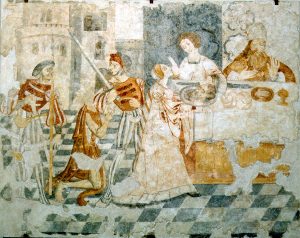
Beheading of Saint John the Baptist
Author: Unknown master
Date: 1510 – 1530
Material: Plaster and pigments
Dimensions (cm): H 190 x W 239
Provenance: Guimarães, chapter room of the Convento de São Francisco
Inventory No.: MAS PD 1
The biblical episode of the Beheading of Saint John the Baptist is represented in two spaces: an exterior one – with Saint John the Baptist, already headless, next to two soldiers – and an inside one – where Salome hands the head of Saint John the Baptist to her mother Herodias, who is at the table next to King Herod, having as a background a tapestry or a guadameci. These two spaces share the same pavement that extends to the architecture in the background.
So, as Paula Bessa mentions, the workshop that executed this painting projected the composition to indicate a palatial scenery of the time when the picture was made: a banquet is taking place on a scenery with a pano de armar (fabric used as a wall hanging) with a brocade pattern behind the king and his queen, Herodias, who are sitting at the table on which there are delicacies and objects that one might expect to find in a 16th-century ceremony and table. The guards’ clothes themselves correspond to the ones used in this time and the same happens with the clothes of the remaining depicted characters.
The Beheading of Saint John the Baptist presents a group of remarkable characteristics that are systematically present in the works of the workshop that made this painting. According to the informed opinion of Ignace Vandevivere and of José Alberto Seabra Carvalho, this painting may be the work of a painter whose name is unknown but who has been designated as The Delirious Master of Guimarães.
The fresco of the Beheading of Saint John the Baptist and the no longer existing fresco of the Baptism of Christ were the main themes of the fresco decoration of the chapter room, where there was, on the second half of the 16th century, a chapel dedicated to Saint John the Baptist. Its preservation was due to the effort of the first director of the Museu de Alberto Sampaio who informed about the existence of other frescos scattered throughout several dependencies of the convent that, except for the one of the Franciscan Saints, were lost.
